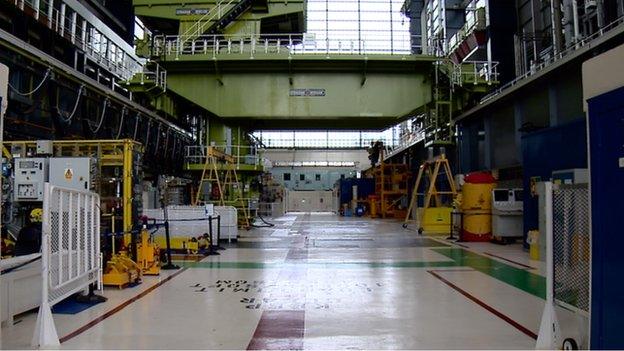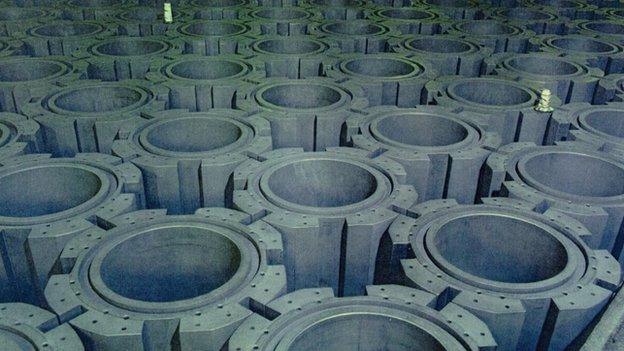Cracks found at reactor at Hunterston B nuclear power station
- Published
Hunterston B has two advanced gas-cooled reactors and began operating in 1976
New cracks have been found in one of the reactors at Hunterston B nuclear power station in North Ayrshire.
Two of about 3,000 graphite bricks in the core of reactor four are affected.
Plant operator, EDF Energy, said the cracking was predicted to occur as the station aged and it would not affect the safe operation of the reactor.
Deputy First Minister Nicola Sturgeon said the issue was "hugely concerning" to the public and that the Scottish government was seeking reassurances.
"The Scottish government is seeking the information we need to assure the public about safety, because safety is absolutely paramount and cannot be compromised," she said.
A Scottish government spokesman added: "The Office for Nuclear Regulation have provided an assurance that there are no immediate safety implications affecting Hunterston B, and that it is safe to continue generating electricity."
The spokesman said the government remained "opposed to the building of new nuclear capacity in Scotland" but the lifetime of existing nuclear plants could be extended to help maintain supply "subject to strict safety considerations" being in place.
The cracks were found during a routine inspection which began in August. These have occurred since the last inspection in 2011.
EDF Energy said the cracking was predicted to happen as the plant aged and did not compromise its safety.
'Cracks predicted'
Colin Weir, station director at Hunterston B, said: "Every time we take the reactor out of service for planned maintenance we inspect the graphite core, which is made up of around 6,000 bricks.
"During the current Hunterston outage we found two bricks with a new crack, which is what we predicted during Hunterston B's lifetime as a result of extensive research and modelling.
"It will not affect the operation of this reactor and we also expect that a few additional cracks will occur during the next period of operation."
Mr Weir added: "The small number of cracked bricks found during routine inspection is in line with our expectations. The findings have no safety implications and are well within any limits for safe operation agreed with our regulator."
Mr Weir's assertions were backed by Brian Cowell, director of nuclear operations at EDF Energy.
He said: "What we have found here is that our models and mathematical assumptions are absolutely underpinned by our findings.
"Therefore, they have revalidated again the fact that we have got these massive safety margins and the (reactor) cores will behave as we have predicted in extreme events, which is exactly what we want."
Mr Cowell added: "They are safe."
The reactor returned to service on Sunday evening, after the energy firm received approval from the Office for Nuclear Regulation.
It is, however, not supplying electricity to the grid as the start-up process takes time.
'Strict safety'
A spokeswoman for EDF said a process known as "turbine balancing" was taking place and the rector would begin supplying electricity "some time soon".
Dr Richard Killick, a former director of safety at Scottish Nuclear, said there was no cause for alarm over the identification of cracks which were "expected".
Speaking on BBC Radio's Good Morning Scotland programme, he said: "The reactor will be shut down for a very thorough inspection, a periodic safety review, every five years or so and and the blocks will be inspected for any signs of cracking.

Hunterston has had its working life extended to 2023
"These cracks are very small hairline cracks, in only two of the blocks, and we can have complete faith in our office for nuclear regulation, who are very strict about safety.
"If they are happy that the reactors are safe to continue then we can be sure that is so."
Keith Parker, chief executive of the Nuclear Industry Association, said no station would be allowed to stay open if there were concerns about safety.
He told Good Morning Scotland: "The independent nuclear regulator would not allow stations to operate if they were not satisfied that safety standards were being met.
'Safety margins'
"EDF Energy have said that these cracks were anticipated as the reactor ages but they and the regulator have both said that they're satisfied that the station is within the safety margins and can continue to operate for several years ahead."
Hunterston B has two advanced gas-cooled reactors, similar to those found at nuclear plants around the UK.
Hunterston began operating in 1976 and its working life has already been extended to 2023 - well beyond its planned closure date.
The issue of cracking in bricks around the core has prompted the Scottish government to ask for information to help reassure the public on safety issues.
Anti-nuclear groups said the issue called in to question the future of nuclear power.
WWF Scotland director Lang Banks said: "These cracks are a sign that we can expect these nuclear facilities to become increasingly unreliable in the future.
"As Scotland continues to grow its renewables capacity we can look forward to a day when we can switch off nuclear power for good."
Peter Roach, editor of the No to Nuclear Power website, told Radio Scotland that it was time the gas-cooled reactors were retired.
"These reactors are getting too old to keep going for much longer," he said.
"They're about 40 years old and there's definitely a problem with the cracking in the graphite blocks that one nuclear engineer has described as gambling with public safety."
- Published6 October 2014

- Published7 August 2014

- Published19 February 2014
